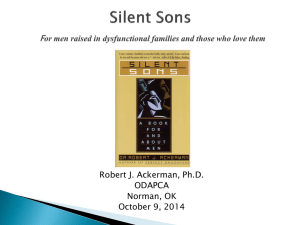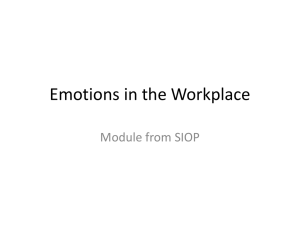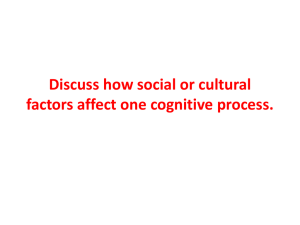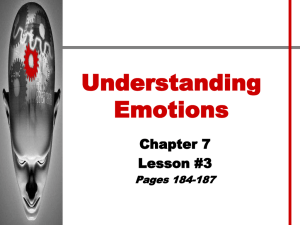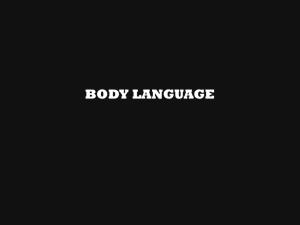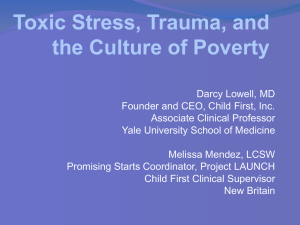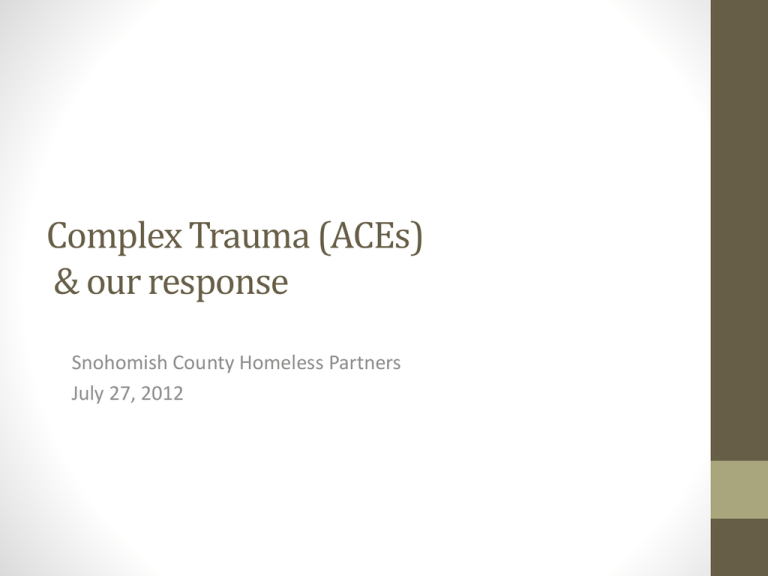
Complex Trauma (ACEs)
& our response
Snohomish County Homeless Partners
July 27, 2012
Learning Targets
• Adverse Childhood Experiences/Complex Trauma
• Brain Development as it relates to Complex
Trauma
• The Attachment, Self-Regulation and
Competency Framework
Credits
• Ron Hertel, OSPI Compassionate Schools
Initiative
• Dr. Rob Anda, CDC
• Family Policy Council
• Susan Martin, ESD 105
• Dr. Chris Blodgett, WSU CTTN
• Margaret Blaustein & Kristine Kinniburgh,
Justice Resource Institute
• Julian Ford, University of Connecticut
The “Why”
• Think of a client/student
• Share information about this client/student with
a table-mate
http://www.k12.wa.us/CompassionateSchools/HeartofLearning.aspx
Compassionate Schools—p 12-13
• Do your
kids/clients
have trouble…
Acquiring
academic
skills?
Compassionate Schools—p 12-13
• Do your
kids/clients
have trouble…
•
Processing
information?
Compassionate Schools—p 12-13
• Do your
kids/clients
have trouble…
•
Using language to
relate to others?
Compassionate Schools—p 12-13
• Do your
kids/clients
have trouble…
Organizing,
remembering and
storing
information?
Compassionate Schools—p 12-13
• Do your
kids/clients
have trouble…
•
Defining
boundaries, solving
problems and
working in groups?
Compassionate Schools—p 12-13
• Do your
kids/clients
have trouble…
• With transitions
Compassionate Schools—p 12-13
• Are your
kids/clients…
Hyperactive,
Impulsive,
Reactive,
Prone to mood
swings?
If you answered “yes” to these
questions…
• …Then
your students may have experienced
Complex Trauma.
What are ACEs?
• Adverse Childhood Experiences study
• CDC and Kaiser Permante—HMO (1997)
• Relationship between childhood trauma and health and
behavioral outcomes later in life
• Higher ACEs score related to higher prevalence of liver,
lung, kidney, and heart disease
• Higher ACEs score related to higher prevalence of
addictive disorders, mental health disorders, obesity
Do my kids/clients have ACEs?
1. Did a parent or other adult in the
household often or very often…
Swear, insult, put down, or
humiliate the client
or
Act in a way that made him/her
afraid that he/she might be
physically hurt?
2. Did a parent or other adult in the
household often or very often…
Push, grab, slap, or throw something
at the client?
or
Ever hit him/her so hard that
he/she had marks or were injured?
3. Did an adult or person at least 5
years older than the cleint ever…
Touch or fondle him/her or have
him/her touch their body in a sexual
way?
or
Attempt or actually have oral, anal,
or vaginal intercourse with
him/her?
4. Did the client often or very
often feel that …
No one in their family loved
him/her or thought he/she
was important or special?
or
Their family didn’t look out for
each other, feel close to each
other, or support each other?
5. Did the client often or very often
feel that …
He/She didn’t have enough to eat,
had to wear dirty clothes, and had
no one to protect him/her?
or
His/her parents were too drunk or
high to take care of them or take
them to the doctor if they needed it?
6. Were the client’s parents
ever separated or divorced?
7. Was the client’s mother or stepmother:
Often or very often pushed, grabbed,
slapped, or had something thrown at her?
or
Sometimes, often, or very often kicked,
bitten, hit with a fist, or hit with something
hard?
or
Ever repeatedly hit at least a few minutes
or threatened with a gun or knife?
8. Did the client live with
anyone who was a problem
drinker or alcoholic or who
used street drugs?
9. Was a household member
depressed or mentally ill, or
did a household member
attempt suicide?
10. Did a household member
go to prison?
Add the “yes’s” to get an ACE score
What are Adverse Childhood
Experiences?
• Physical abuse
• Sexual abuse
• Emotional abuse
• Physical/Emotional Neglect
• Mental illness in the home
• Substance Abuse in the home
• Witnessing domestic violence
• Loss of parent, especially to death or
abandonment, including by divorce
• Incarceration of any family member
My Why is “K”
Substance abuse in the home
Absence of Parent through death or divorce
Emotional Abuse
Mental Illness in the home
Sexual Abuse
Neglect
Domestic Violence
Incarceration of Family Member
Physical Abuse
What is Traumatic Stress?
• Overwhelming Experience (not day to day stress)
• Involves a threat
• Vulnerability/Loss of control
• Helpless and Fearful
• Interferes with relationships and beliefs
• Varies by person
• Can be layered
Complex Trauma
• Exposure to multiple traumatic events,
frequently within the care giving system
• Impact of these events effects individual
development and has both immediate and long
term outcomes
Let’s talk about Brains
Brain Development
Key Points
1. The brain develops from the most primitive functions
to the most complex
2. Normal development of systems and functions they
mediate requires specific signals at specific times
3. These critical periods are times of sensitivity to
environmental input—including traumatic experience
4. Different functions (regulation of anxiety, mood,
abstract thought) develop or mature at different
times in the life of a child
Source: Bruce Perry, MD, PhD
Brain Development:
Adverse Childhood
Experiences and Complex
Trauma
BRAIN DEVELOPMENT PATTERNS
Adapted from the research of Martin Teicher, MD, PhD
BRAIN
Hormones, chemicals &
cellular systems prepare
for a tough life in an evil
world
INDIVIDUAL
•Edgy
•Hot temper
•Impulsive
•Hyper vigilant
•“Brawn over
brains”
Traumatic
Event
NEUTRAL
START
BRAIN
Hormones, chemicals &
cellular systems prepare
for life in a benevolent
world
INDIVIDUAL
•Laid back
•Relationshiporiented
•Thinks things
through
•“Process over
power”
OUTCOME
Individual &
species survive
the worst
conditions.
Dissonance
between
biological
expectations &
social reality
OUTCOME
Individual &
species live
peacefully in
good times;
vulnerable in
poor conditions
KEY VARIABLES IN BRAIN OUTCOMES
FRONT
CRITICAL TIME:
AGE OF
MALTREATMENT
TYPE OF ABUSE
Different types of
maltreatment activate
different processes that
shape the brain, such
as chemicals &
hormones, electrical
activity, cell growth, &
specialization of cells.
The brain develops over
time. The effects of
maltreatment correspond
to the region and/or
function that is
developing at the time of
maltreatment.
BACK
GENDER
Although both boys & girls are
affected by maltreatment the effects
of sexual abuse are more profound in
girls while the effects of neglect are
BRAIN EFFECTS BY CRITICAL PERIODS
CRITICAL
TIME
BRAIN REGION
First 3 years
HIPPOCAMPUS
Ages 3-5
Infancy
Age 8-10
Age 7-9
Prior to
puberty
First 2-3 yrs
Age 8-10
Age 15-16
FUNCTION
Emotional regulation
Verbal memory
Spatial memory
With the AMYGDALA,
Manages fear, panic, emotional understanding
Regulates emotionally-appropriate responses
Puts the brakes on outbursts & tantrums
CORPUS CALLOSUM Cross-brain function
Language & math proficiency
Social cues
RT TEMPORAL
GYRUS
CEREBELLAR
VERMIS
CORTEX
Spoken language
Center for mental health
Navigation through space
Track periphery
Thinking and judgment
Vision
Executive function
Long-term memory
AFFECTED BY
All maltreatment
Sexual abuse
Neglect
Sexual abuse
Emotional abuse
All maltreatment
All maltreatment
Witnessing Family
Violence
Sexual abuse
How prevalent are
ACEs/Complex Trauma?
ACEs in Snohomish County
• HYS Question # 108
• Have you ever been physically abused by
an adult?
• Snohomish
• State
8th
10th Grade
15.4%
15.6%
19.2%
18.2%
ACEs in Snohomish County
• HYS Question #109
• Not counting TV, movies, video games, and
sporting events, have you seen an adult hit,
slap, punch, shove, kick, or otherwise
physically hurt another adult more than one
time?
• Snohomish
• State
8th
10th
25.2%
25.8%
27.6%
27.6%
Population
Average
What is the impact on
learning?
From “The Heart of Learning
and Teaching”
•
Students with ACEs:
·Are 2 ½ times more likely to fail a grade
·Score lower on standardized tests
·Have language difficulties
·Are suspended or expelled more
·Are designated to special education more
frequently
•
Have poorer health
ADVERSE CHILDHOOD EXPERIENCE
JUVENILE OFFENDERS:
ACES & SCHOOL EXPERIENCE
100%
90%
80%
70%
60%
50%
40%
30%
20%
10%
0%
82%
85%
71%
61%
64%
43%
4+ Suspensions
0-1 ACEs
Early Suspension
2-3 ACEs
4+ ACEs
ADVERSE CHILDHOOD EXPERIENCE
JUVENILE OFFENDERS:
ACES & SCHOOL EXPERIENCE
100%
80%
74%
69%
60%
58%
51%
40%
41%
20%
33%
0%
Special Education
0-1 ACEs
Below 2.0 GPA
2-3 ACEs
4+ ACEs
Trauma impacts…
• A youth’s ability to attach
• A youth’s social emotional development
• Communication and Connectedness
• Empathy, Compassion & Respect
• Emotional regulation
• Hopeless, inability to impact world
• Unsure of needs or how to get them met
• Cognition and language
• Survival trumps exploration and growth (i.e. learning)
• Lack of executive functioning
Review & Questions--Trauma
• Adverse Childhood Experiences/Complex
Trauma
• Brain Development and Complex Trauma
Strategies
The ARC Model
Attachment, Self-Regulation and Competency
Learning Targets
• Attachment, Self-Regulation and
Competency Framework
• Current strategies you are currently using
• Strategies to add to your repertoire
Students/People who have experienced trauma tend
to…
…expect harm from the world & others
…have difficulty forming relationships
…have difficulty managing, understanding &
regulating feelings & behaviors
…have a damaged or fragmented sense of self
…have developmental challenges in the areas of
problem solving & academic performance
SURVIVAL TRUMPS NEW LEARNING
Developmental
Tasks
Ten
Building
Blocks
Executive
Function
Self-Development/Identity
Competency
Affect
Identification
Affect
Modulation
Affect
Expression
Self-Regulation
Affect
Management
Attunement
Consistent
Response
Attachment
Rituals and
Routines
The Goal:
“Simple, Sustained Kindness”
The Heart of Learning and Teaching
Goal—Create an environment that is safe and
supportive so that clients/students can focus on
learning/functioning
Manage staff affect
Teaching staff to attune to client/student’s emotions
Helping staff to respond predictably to client/student
behaviors & emotions
Recognizing the importance of rituals and routines
Goal—Help staff to monitor & regulate their own
emotions so that they can support their
clients/students.
Things that make it tough
Clients/Students can be unpredictable—have triggers
Staff bring in their own experiences to the relationship—
have their own triggers
History of interactions with clients/students
Clients/Students don’t always know how to read
emotions accurately—may read us inaccurately
How do we show:
Anger
Frustrated
Stressed out
Confused
They all look similar to kids.
http://www.youtube.com/watch?v=apzXGEbZht0
Discuss with someone at your table
What client/student behaviors are particularly
hard for you?
What client/student emotions are particularly
hard for you?
What situations do you feel most/least
effective?
What outside factors make it difficult to stay
centered?
What have you found works for you?
Your toolbox for Affect
Management—Share your
strategies
Goals of Affect Management
• Do not fake emotions or pretend that you don’t
have an emotional response
• Depersonalize child/client behaviors
• Validate caregiver experience
• Monitor affect and maintain boundaries
• Respond constructively
• Communicate to youth that adults around them
are safe, calm and able to handle difficult
experiences
Become an emotion/feeling detective
Learn client/student “triggers”
Depersonalize the behaviors
Listening skills (reflective)
Help client/child learn to read adult behaviors
Misread adult emotions (over read)
Attunement
• What is Attunement?
• The capacity of caregivers and children to accurately
read each other’s cues and respond accordingly
• Respond to the client/child’s emotion rather than the
behavior
Goal—Learn to read cues and respond to
underlying student emotions
Client/Students have difficulty understanding their
own emotions and communicating them
appropriately
Client/Students use behaviors to communicate their
emotions
Common Triggers for
Clients/Children who have
experienced trauma
• Unpredictability
(sudden changes)
• Transitions
• Loss of control
• Vulnerability
• Rejection
• Loneliness
• Over stimulation
• Intimacy
• Quiet
• Calm
• Confrontation
Communication Indicators
Watch for Changes in…
• Facial Expressions
• Intense/Lack of
• Tone of voice
• Pitch/volume
• Extent of speech
• Verbose/quiet/rate
• Physical
• Approach
• Withdrawn/clingy
• Mood
Steps
• Be attuned (watch for shifts)
• Keep yourself centered
• Ask yourself questions (energy level)
• Reflect out loud to child/client (name energy
level)
• Cue client/child
• Model for client/child (“When I…”)
• Reinforce
• Reflect
Consider the following
• What behaviors are we concerned with?
• What has the client/child experienced?
• Other factors (i.e. culture, parent situation)
• How might these have impacted the client/child?
• What patterns have developed as a result of
these experiences?
• Are there triggers?
• Current stressors?
• What are the client/child’s strengths?
Select an action and discuss with partner possible
emotions/feelings behind these actions:
Sleeping in class
Angry outburst
Refusal to move to new seat/anger over new
seating arrangement or another transition
Goal—Respond in consistent way to both positive
and negative client/student behaviors.
Predictability
Reduce vulnerability (reduce “out of control”)
Learn cause and effect; boundaries; standards
Care givers provide safety (remind parents)
Recommendations
Pay attention to praise/correction to see
how client/student responds
Focus on building success
Be specific
Empower rather than dis-empower
(Compassionate Schools)
Predictability is key so client/student
doesn’t feel like he/she needs to adapt
his/her behavior to elicit desired response
from staff
Praise and Trauma
• Praise doesn’t match self-view
• Fear of attachment to adult
• Praise led to or followed traumatic event
• Keep in mind…
• Don’t take it personally
• Be persistent
• Don’t argue with rejection
• “Stay tuned”
• Maintain standards
Things to consider
•
•
•
•
•
•
•
•
•
Traumatized clients/children need control
Provide choices (illusion of control)
Use attunement to determine reason for non-compliance
Break large tasks into small ones
Offer to help
Choose your moments
Be aware of triggers
Link limits to behavior (cause and effect)
Move on (don’t rehash events)
Goal—Help establish routines and rituals
for the client/student
Build predictability and sense of control
Clients/Children may have strong reaction to
change
Routines & predictability increase sense of
security & sense of safety
Make shift from survival to healthy
development
Routines
Target transitions--lunch routines, recess
routines, changing classes, arriving, leaving…
Encourage parents to build routines at home
Bedtime
Homework
Lack of predictability has become rule
rather than exception
Rituals
• Repeated practice of traditions, celebrations,
patterns of behavior
• Connects client/child to others (family, school,
culture)
• Provide sense of belonging
Considerations
It’s about attachment…
•
•
•
•
Consistency
Rules (safety, boundaries)
Developmental needs
Transitions are important
• Time/punctuality
• Time Cues
• Break up activities
• Location
• No all rituals/routines have been positive
Consistent Response
What consistent responses do you currently employ?
What client/student behaviors trigger responses from
you?
Routines and Rituals
What routines/rituals do you have?
What routines/rituals does your
school/classroom/office have?
What routines can you add that would help
client/students?
Second Tier—Self-Regulation
Overarching Goal—Help clients/students learn
to identify, control, and communicate their
emotions.
Identify emotions
Modulate emotions
Effectively communicate and express their emotions
to staff and others
Typical Modulation Development
• Reflection “You look like your are getting sleepy”
• Modeling—Caregiver experiences stress and
calms himself
• Stimulation and Soothing—physiological
organization
The Human Brain
Doing Brain
Thinking Brain
• Where response to
threat and danger occurs
• Acts like an alarm and
signals us when we
might be in danger
• Responsible for planning,
organizing and problem
solving
• Assesses if there is actual
danger
• Medina—the 4 Fs
• Complicated by triggers
• Fight, flight, freeze…
Block R1—Affect Identification
Goal—awareness of emotions; why they are
feeling that way; plus learning how to read
others’ emotions
Clients/Students may be unaware of emotions (their
own and others)
Unaware of the connection between what is
happening and how they are feeling, both emotionally
and physically.
Use literature, pictures, music, film to help kids learn
to identify emotions.
Steps to build affect identification
• Build vocabulary
• Talk your thoughts
• Connect emotions with:
• Body sensations
• Thoughts associated with feelings
• Behaviors—manifestations of feelings
• Context
• External: Identification of triggers
• Internal: Tired, hungry
Possible Activities
• Emotion collage
• Emotion flashcards
• Potential reason for emotion
• What kinds of things might make child feel
that way
• Emotion Charades
• Single word “acts”
• Yes, No, Hmmm
• Emotion – Behavior Pairing
Block R2—Affect Modulation
Influences on Modulation
Attachment
Generally children rely on parents to be
“external modulators”
Traumatic Stress Response
Extreme regulation
Stress leads to immediate “danger zone”
Affect Modulation
Goal—Help client/student learn to regulate
their emotions and energy level
Without substances
Avoid Extremes (emotional or physical)
Avoid Shutting down
Client/Students need to be able to get to the
center so they can learn/work
Identify initial state (comfort zone)
Recognize changes in emotional states
Recognize ability to change emotional state (expand
comfort zone)
Can’t work/learn at the extremes
Steps to teach Modulation
• Normalize “energy”
• Link energy to feelings
• Understand “comfort zone”
• Understand energy in context
(playground/pep assembly/sporting event
versus classroom/office/church)
• Sense of control over energy
Excitement
Anger
Sadness
Worry
Fear
Small objects
to manipulate
Push against
wall/door
Object
associated w/
comfort
Paper to write
down worries
Picture of a
safe place
Bubbles
Stress ball
List of
distractions
Think of
someone who
makes you feel
safe
Exercise
Clay
Soothing
sensory object
Draw/journal
Scents
Block R3—Affect Expression
Goal—Help clients/kids learn to express their
emotions in a way that helps them meet their
needs
Previously have experienced inconsistencies
with sharing their emotions
Can lead to vulnerability
The inability to express emotions makes it
difficult to form healthy relationships
Context matters (sharing with counselor
versus classmate)
Affect Expression Skill Targets
Help clients/students understand why
it is important to communicate
emotions and how to do so
Who is safe to share information with?
Picking the time to share
Initiating conversation
Using non-verbal communication
Competency
Over arching goal—Help clients/students
become more resilient and continue to
learn and develop
Helping to build executive functioning
skills
Target self-development
Identify key developmental tasks
Block C1—Executive Function
Goal—Help clients/students develop the ability
to evaluate the situation, control impulses, and
make appropriate choices.
Help clients/students achieve goals, anticipate
consequences, evaluate outcomes, come up
with solutions
Occurs in the prefrontal cortex which is often
underdeveloped due to complex trauma
Provides sense of control
Builds resilience
Block C2—Self-Development and
Identity
Goal—Help clients/kids understand their own
positive identity
Internalize negative experiences
May have missed out in early childhood on experiences
that help them relate to others
May have missed out on development of values
May not understand the link between their actions and
their future
May be afraid to try new things—fear of failure
Self-Development & Identity
Unique Self—Identify individual attributes: values,
talents, opinions, cultural influence
Positive Self—Identify positive attributes.
Cohesive Self—How past experiences make you
what you are; integrate multiple aspects of self
Future Self—Envision future, connect current
activities with future outcomes
Block C3--Trauma Experience
Integration
Work with client/student to explore & process
past experiences to help them live effectively in
the present.
Negative past experiences can interfere with
the students ability to navigate in their current
life.
Current experiences may elicit responses that
were helpful in their past, but might not be in
current setting
Already have developed a pattern of
responding.
Vicarious Trauma
• Client/Students’ needs come before our needs
• Too much to do
• Guilt
• Self Care ABC’s
• Awareness
• Balance
• Connection
• Reset your body—physically
• Check in with yourself at least once per week
Self-Care
• Vicarious Trauma—Natural part of working
directly with people who have experienced
complex trauma.
• Managing behaviors
• Empathizing
• Rescuing
• Hearing stories
• Important to take care of ourselves
• Watch for burnout
The book…
• Treating Traumatic Stress in Children and
Adolescents: How to Foster Resilience
through Attachment, Self-Regulation and
Competency
-Margaret E. Blaustein
-Kristine M Kinniburgh
Dedications
• Kayla
• Wyatt
• Jamie
• Justin
• Kate
• …and all of the Josh’s, Jeremy’s, Jacobs, Jessica’s
and other “J” names that have inspired me to
learn
Maurene Stanton
360-299-4010
mstanton@nwesd.org





